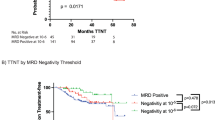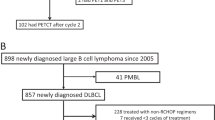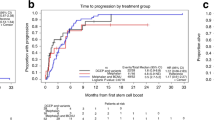Abstract
18F-Fluorodeoxyglucose positron emission tomography/computed tomography (PET) positivity after first-line treatment with autologous stem cell transplantation (ASCT) in multiple myeloma is strongly correlated with reduced progression-free and overall survival. However, PET-positive patients who achieve PET negativity after treatment seem to have comparable outcomes to patients who were PET negative at diagnosis. Hence, giving PET-positive patients additional treatment may improve their outcome. In this phase II study, we screened first-line patients with very good partial response (VGPR) or better after ASCT with PET. PET-positive patients received four 28-day cycles of carfilzomib-lenalidomide-dexamethasone (KRd). Flow cytometry-based minimal residual disease (MRD) analysis was performed before and after treatment for correlation with PET. Overall, 159 patients were screened with PET. A total of 53 patients (33%) were PET positive and 57% of PET-positive patients were MRD negative, demonstrating that these response assessments are complementary. KRd consolidation converted 33% of PET-positive patients into PET negativity. MRD-negative patients were more likely to convert than MRD-positive patients. In summary, PET after ASCT detected residual disease in a substantial proportion of patients in VGPR or better, even in patients who were MRD negative, and KRd consolidation treatment changed PET status in 33% of patients.
This is a preview of subscription content, access via your institution
Access options
Subscribe to this journal
Receive 12 print issues and online access
$259.00 per year
only $21.58 per issue
Buy this article
- Purchase on Springer Link
- Instant access to full article PDF
Prices may be subject to local taxes which are calculated during checkout



Similar content being viewed by others
Data availability
The datasets generated during and/or analyzed during the current study are available from the corresponding author on reasonable request, please contact the corresponding author by e-mail: jaknoe@ous-hf.no.
References
Thorsteinsdottir S, Dickman PW, Landgren O, Blimark C, Hultcrantz M, Turesson I, et al. Dramatically improved survival in multiple myeloma patients in the recent decade: results from a Swedish population-based study. Haematologica. 2018;103:e412–5.
Chakraborty R, Muchtar E, Kumar S, Buadi FK, Dingli D, Dispenzieri A, et al. The impact of induction regimen on transplant outcome in newly diagnosed multiple myeloma in the era of novel agents. Bone Marrow Transplant. 2017;52:34–40.
Corre J, Montes L, Martin E, Perrot A, Caillot D, Leleu X, et al. Early relapse after autologous transplant for myeloma is associated with poor survival regardless of cytogenetic risk. Haematologica. 2020;105:e480–3.
Bartel TB, Haessler J, Brown TL, Shaughnessy JD Jr, van Rhee F, Anaissie E, et al. F18-fluorodeoxyglucose positron emission tomography in the context of other imaging techniques and prognostic factors in multiple myeloma. Blood. 2009;114:2068–76.
Zamagni E, Patriarca F, Nanni C, Zannetti B, Englaro E, Pezzi A, et al. Prognostic relevance of 18-F FDG PET/CT in newly diagnosed multiple myeloma patients treated with up-front autologous transplantation. Blood. 2011;118:5989–95.
Moreau P, Attal M, Caillot D, Macro M, Karlin L, Garderet L, et al. Prospective evaluation of magnetic resonance imaging and [(18)F]fluorodeoxyglucose positron emission tomography-computed tomography at diagnosis and before maintenance therapy in symptomatic patients with multiple myeloma included in the IFM/DFCI 2009 Trial: results of the IMAJEM study. J Clin Oncol. 2017;35:2911–8.
Kaddoura M, Dingli D, Buadi FK, Lacy MQ, Gertz MA, Dispenzieri A, et al. Prognostic impact of posttransplant FDG PET/CT scan in multiple myeloma. Blood Adv. 2021;5:2753–9.
Davies FE, Rosenthal A, Rasche L, Petty NM, McDonald JE, Ntambi JA, et al. Treatment to suppression of focal lesions on positron emission tomography-computed tomography is a therapeutic goal in newly diagnosed multiple myeloma. Haematologica. 2018;103:1047–53.
Roussel M, Lauwers-Cances V, Wuilleme S, Belhadj K, Manier S, Garderet L, et al. Up-front carfilzomib, lenalidomide, and dexamethasone with transplant for patients with multiple myeloma: the IFM KRd final results. Blood. 2021;138:113–21.
Stewart AK, Dimopoulos MA, Masszi T, Špička I, Oriol A, Hájek R, et al. Health-related quality-of-life results from the open-label, randomized, Phase III ASPIRE Trial evaluating carfilzomib, lenalidomide, and dexamethasone versus lenalidomide and dexamethasone in patients with relapsed multiple myeloma. J Clin Oncol. 2016;34:3921–30.
Jackson GH, Davies FE, Pawlyn C, Cairns DA, Striha A, Collett C, et al. Response-adapted intensification with cyclophosphamide, bortezomib, and dexamethasone versus no intensification in patients with newly diagnosed multiple myeloma (Myeloma XI): a multicentre, open-label, randomised, phase 3 trial. Lancet Haematol. 2019;6:e616–29.
Goldschmidt H, Mai EK, Dürig J, Scheid C, Weisel KC, Kunz C, et al. Response-adapted lenalidomide maintenance in newly diagnosed myeloma: results from the phase III GMMG-MM5 trial. Leukemia. 2020;34:1853–65.
Costa LJ, Chhabra S, Medvedova E, Dholaria BR, Schmidt TM, Godby KN, et al. Daratumumab, carfilzomib, lenalidomide, and dexamethasone with minimal residual disease response-adapted therapy in newly diagnosed multiple myeloma. J Clin Oncol. 2022;40:2901–2912.
Rajkumar SV, Dimopoulos MA, Palumbo A, Blade J, Merlini G, Mateos MV, et al. International Myeloma Working Group updated criteria for the diagnosis of multiple myeloma. Lancet Oncol. 2014;15:e538–48.
Boellaard R, Delgado-Bolton R, Oyen WJG, Giammarile F, Tatsch K, Eschner W, et al. FDG PET/CT: EANM procedure guidelines for tumour imaging: version 2.0. Eur J Nucl Med Mol Imaging. 2015;42:328–54.
Nanni C, Zamagni E, Versari A, Chauvie S, Bianchi A, Rensi M, et al. Image interpretation criteria for FDG PET/CT in multiple myeloma: a new proposal from an Italian expert panel. IMPeTUs (Italian Myeloma criteria for PET USe). Eur J Nucl Med Mol Imaging. 2016;43:414–21.
Aaronson NK, Ahmedzai S, Bergman B, Bullinger M, Cull A, Duez NJ, et al. The European Organization for Research and Treatment of Cancer QLQ-C30: a quality-of-life instrument for use in international clinical trials in oncology. J Natl Cancer Inst. 1993;85:365–76.
Magasi S, Mallick R, Kaiser K, Patel JD, Lad T, Johnson ML, et al. Importance and relevance of pulmonary symptoms among patients receiving second- and third-line treatment for advanced non–small-cell lung cancer: support for the content validity of the 4-Item Pulmonary Symptom Index. Clin Lung Cancer. 2013;14:245–53.
Postma TJ, Aaronson NK, Heimans JJ, Muller MJ, Hildebrand JG, Delattre JY, et al. The development of an EORTC quality of life questionnaire to assess chemotherapy-induced peripheral neuropathy: The QLQ-CIPN20. Eur J Cancer. 2005;41:1135–9.
Arroz M, Came N, Lin P, Chen W, Yuan C, Lagoo A, et al. Consensus guidelines on plasma cell myeloma minimal residual disease analysis and reporting. Cytometry B Clin Cytom. 2016;90:31–9.
Fayers PAN, Bjordal K, Groenvold M, Curran D, Bottomley A. EORTC QLQ-C30 scoring manual. 3rd ed. Brussels: European Organisation for Research and Treatment of Cancer; 2001.
Cocks K, King MT, Velikova G, de Castro G, Martyn St-James M, Fayers PM, et al. Evidence-based guidelines for interpreting change scores for the European Organisation for the Research and Treatment of Cancer Quality of Life Questionnaire Core 30. Eur J Cancer. 2012;48:1713–21.
Charalampous C, Goel U, Broski SM, Dingli D, Kapoor P, Gertz MA, et al. Utility of PET/CT in assessing early treatment response in patients with newly diagnosed multiple myeloma. Blood Adv. 2022;6:2763–72.
Zamagni E, Nanni C, Dozza L, Carlier T, Bailly C, Tacchetti P, et al. Standardization of 18F-FDG–PET/CT according to deauville criteria for metabolic complete response definition in newly diagnosed multiple myeloma. J Clin Oncol. 2020;39:116–25.
Zamagni E, Nanni C, Gay F, Dozza L, Rota Scalabrini D, D’Agostino M, et al. Impact of imaging FDG-PET/CT minimal residual disease assessment on outcomes and matching with bone marrow techniques in newly diagnosed transplant eligible multiple myeloma (MM) patients: results of the Phase II Randomized Forte Trial. Blood. 2020;136:27–8.
Kumar S, Paiva B, Anderson KC, Durie B, Landgren O, Moreau P, et al. International Myeloma Working Group consensus criteria for response and minimal residual disease assessment in multiple myeloma. Lancet Oncol. 2016;17:e328–46.
Paiva B, Vidriales M-B, Cerveró J, Mateo G, Pérez JJ, Montalbán MA, et al. Multiparameter flow cytometric remission is the most relevant prognostic factor for multiple myeloma patients who undergo autologous stem cell transplantation. Blood. 2008;112:4017–23.
de Tute RM, Pawlyn C, Cairns DA, Davies FE, Menzies T, Rawstron A, et al. Minimal residual disease after autologous stem-cell transplant for patients with myeloma: prognostic significance and the impact of lenalidomide maintenance and molecular risk. J Clin Oncol. 2022;40:2889–900.
Munshi NC, Avet-Loiseau H, Rawstron AC, Owen RG, Child JA, Thakurta A, et al. Association of minimal residual disease with superior survival outcomes in patients with multiple myeloma: a meta-analysis. JAMA Oncol. 2017;3:28–35.
Alonso R, Cedena MT, Gomez-Grande A, Rios R, Moraleda JM, Cabanas V, et al. Imaging and bone marrow assessments improve minimal residual disease prediction in multiple myeloma. Am J Hematol. 2019;94:853–61.
Cavo M, Terpos E, Nanni C, Moreau P, Lentzsch S, Zweegman S, et al. Role of (18)F-FDG PET/CT in the diagnosis and management of multiple myeloma and other plasma cell disorders: a consensus statement by the International Myeloma Working Group. Lancet Oncol. 2017;18:e206–17.
Rasche L, Angtuaco E, McDonald JE, Buros A, Stein C, Pawlyn C, et al. Low expression of hexokinase-2 is associated with false-negative FDG-positron emission tomography in multiple myeloma. Blood. 2017;130:30–4.
Lapa C, Garcia-Velloso MJ, Luckerath K, Samnick S, Schreder M, Otero PR, et al. (11)C-Methionine-PET in multiple myeloma: a combined study from two different institutions. Theranostics. 2017;7:2956–64.
Stokke C, Nørgaard JN, Feiring Phillips H, Sherwani A, Nuruddin S, Connelly J, et al. Comparison of [18F]fluciclovine and [18F]FDG PET/CT in newly diagnosed multiple myeloma patients. Mol Imaging Biol. 2022;24:842–51.
Dytfeld D, Wróbel T, Jamroziak K, Kubicki T, Robak P, Walter-Croneck A, et al. Carfilzomib, lenalidomide, and dexamethasone or lenalidomide alone as maintenance therapy after autologous stem-cell transplantation in patients with multiple myeloma (ATLAS): interim analysis of a randomised, open-label, phase 3 trial. Lancet Oncol. 2023;24:139–50.
Acaster S, Gaugris S, Velikova G, Yong K, Lloyd AJ. Impact of the treatment-free interval on health-related quality of life in patients with multiple myeloma: a UK cross-sectional survey. Support Care Cancer. 2013;21:599–607.
Ebraheem MS, Seow H, Balitsky AK, Pond GR, Wildes TM, Sivapathasundaram B, et al. Trajectory of symptoms in patients undergoing autologous stem cell transplant for multiple myeloma: a population-based cohort study of patient-reported outcomes. Clin Lymphoma Myeloma Leuk. 2021;21:e714–21.
Acknowledgements
JNN is a PhD candidate at the University of Oslo. This work is submitted as partial fulfillment of the requirement of the PhD. KG Jebsen Center for B-cell malignancies granted funds for JNN’s PhD education. This trial was supported by research funding and drug supply from Amgen to FS. We want to thank all patients in the study and their relatives.
Author information
Authors and Affiliations
Consortia
Contributions
JNN performed research, collected data, analyzed and interpreted data, performed statistical analysis, wrote the manuscript, and approved the manuscript. NA designed research, performed research, collected data, and approved the manuscript. AL designed research, performed research, collected data, analyzed and interpreted data, and approved the manuscript. GT performed research, collected data, and approved the manuscript. AJV designed research, performed research, collected data, and approved the manuscript. CJ performed research, collected data, and approved the manuscript. NR performed research, collected data, and approved the manuscript. LKN designed the QoL substudy and collected, analyzed and interpreted data, wrote sections of the manuscript, and approved the manuscript. Henrik Eshøj designed the QoL substudy and collected, analyzed and interpreted data, and approved the manuscript. Sadly, Henrik passed away before the study was published. LO analyzed and interpreted data, wrote sections of the manuscript, and approved the manuscript. CS designed research and approved the manuscript. JPC performed research, collected data, analyzed and interpreted data, and approved the manuscript. M-ERR designed research, performed research, collected data, analyzed and interpreted data, wrote sections of the manuscript, and approved the manuscript. FS designed research, performed research, collected data, analyzed and interpreted data, performed statistical analysis, wrote the manuscript, and approved the manuscript.
Corresponding author
Ethics declarations
Competing interests
JNN has received honoraria from Janssen. NA has received research grants from Janssen, Celgene, BMS, Amgen, and Takeda. GT has received consultancy/honoraria from Amgen, Janssen, Ablynx, and Sobi, as well as research funding from Amgen. FS has received honoraria from Amgen, BMS, Abbvie, Janssen, and GSK. He has received grants from Amgen and Targovax and received compensation for adbords from GSK, Takeda, BMS, Janssen, Oncopeptides, Sanofi, and XNK therapeutics. The remaining authors declare no competing interests.
Additional information
Publisher’s note Springer Nature remains neutral with regard to jurisdictional claims in published maps and institutional affiliations.
Rights and permissions
Springer Nature or its licensor (e.g. a society or other partner) holds exclusive rights to this article under a publishing agreement with the author(s) or other rightsholder(s); author self-archiving of the accepted manuscript version of this article is solely governed by the terms of such publishing agreement and applicable law.
About this article
Cite this article
Nørgaard, J.N., Abildgaard, N., Lysén, A. et al. Intensifying treatment in PET-positive multiple myeloma patients after upfront autologous stem cell transplantation. Leukemia 37, 2107–2114 (2023). https://doi.org/10.1038/s41375-023-01998-7
Received:
Revised:
Accepted:
Published:
Issue Date:
DOI: https://doi.org/10.1038/s41375-023-01998-7



